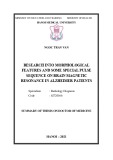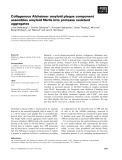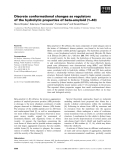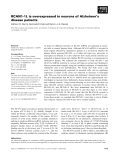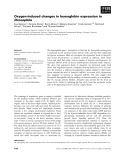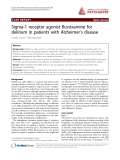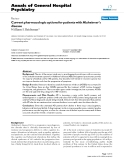
Alzheimer patients
-
Practical questions put forward by clinicians in the past have been researched and settled in the thesis. The AD diagnosis is completely based on clinics and the implementation of clinical tests for the diagnosis work depends on assessors’ subjectivity. Therefore, the development of MRI techniques shall help clinicians make diagnosis more quickly and objectively.
 27p
27p  closefriend09
closefriend09
 16-11-2021
16-11-2021
 33
33
 4
4
 Download
Download
-
Theb-amyloid peptide (Ab) is a major component of toxic amyloid plaques found in the brains of patients with Alzheimer’s disease.Abis liberated by sequential cleavage of amyloid precursor protein (APP) byb-andc-secre-tases.The level of Abdepends directly on the hydrolytic activity ofb-secretase.Therefore, b-secretase is an excel-lent target for drug design.An approach based on RNA-cleaving ribozymes was developed to control expression ofb-secretase.
 9p
9p  tumor12
tumor12
 20-04-2013
20-04-2013
 38
38
 4
4
 Download
Download
-
Recently, a novel plaque-associated protein, collagenous Alzheimer amy-loid plaque component (CLAC), was identified in brains from patients with Alzheimer’s disease. CLAC is derived from a type II transmembrane colla-gen precursor protein, termed CLAC-P (collagen XXV). The biological function and the contribution of CLAC to the pathogenesis of Alzheimer’s disease and plaque formation are unknown.
 0p
0p  awards
awards
 06-04-2013
06-04-2013
 30
30
 2
2
 Download
Download
-
Beta-amyloid (1–40) (Abeta), the main component of senile plaques seen in the brains of Alzheimer’s disease patients, was found to be toxic both as fibrils and smaller soluble globular aggregates. The hydrolytic properties of Abeta, a new biochemical activity described previously [Brzyska M, Bacia A & Elbaum D (2001)Eur J Biochem268, 3443–3454], may contribute to its overall toxicity.
 14p
14p  inspiron33
inspiron33
 23-03-2013
23-03-2013
 39
39
 4
4
 Download
Download
-
At least two different isoforms ofRCAN1mRNA are expressed in neuro-nal cells in normal human brain. AlthoughRCAN1mRNA is elevated in brain regions affected by Alzheimer’s disease, it is not known whether the disease affects neuronal RCAN1, or if other cell types (e.g. astrocytes or microglia) are affected.
 10p
10p  galaxyss3
galaxyss3
 21-03-2013
21-03-2013
 26
26
 4
4
 Download
Download
-
The amyloidbpeptide (Ab) with 39–42 residues is the major component of amyloid plaques found in brains of Alzheimer’s disease patients, and solu-ble oligomeric peptide aggregates mediate toxic effects on neurons. The Ab aggregation involves a conformational change of the peptide structure to b-sheet.
 9p
9p  vinaphone15
vinaphone15
 28-02-2013
28-02-2013
 46
46
 3
3
 Download
Download
-
Tuyển tập các báo cáo nghiên cứu về y học được đăng trên tạp chí y học General Psychiatry cung cấp cho các bạn kiến thức về ngành y đề tài: Sigma-1 receptor agonist fluvoxamine for delirium in patients with Alzheimer’s disease...
 3p
3p  thulanh11
thulanh11
 10-10-2011
10-10-2011
 42
42
 5
5
 Download
Download
-
Tuyển tập các báo cáo nghiên cứu về y học được đăng trên tạp chí y học General Psychiatry cung cấp cho các bạn kiến thức về ngành y đề tài: Current pharmacologic options for patients with Alzheimer's disease...
 14p
14p  thulanh10
thulanh10
 09-10-2011
09-10-2011
 47
47
 5
5
 Download
Download
CHỦ ĐỀ BẠN MUỐN TÌM









